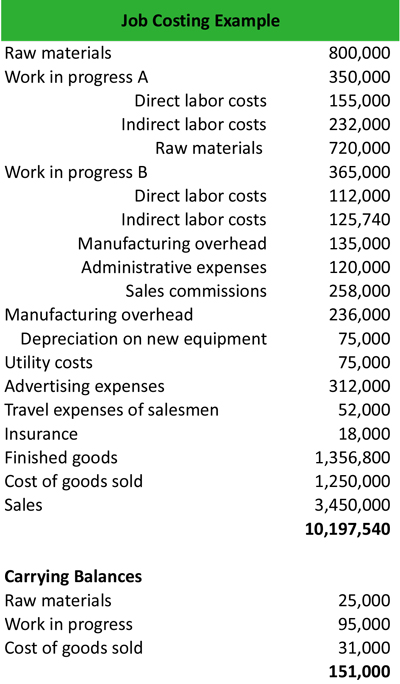
When a company mass produces parts but allows customization on the final product, both systems are used; this is common in auto manufacturing. Each part of the vehicle is mass produced, and its cost is calculated with process costing. However, specific cars have custom options, so each individual car costs the sum of the specific parts used. Manufacturing departments are often organized by the various stages of the production process. Each department, or process, will have its own work in process inventory account, but there will only be one finished goods inventory account. The difference between process costing and job order costing relates to how the costs are assigned to the products.
- You use a rate to apply overhead costs to each job based on how many hours were worked or how many materials were used.
- Job order costing gives an accurate cost assessment for specialized and low-volume orders.
- You’re going to need to calculate the cost of each product individually to know how much you need to charge your customer to make a profit.
Custom-Made Products
This information is vital for determining pricing strategies and profitability. Both process costing and job order costing maintain the costs of direct material, direct labor, and manufacturing overhead. The process of production does not change because of the costing method. SunCo, Inc. assigns manufacturing overhead to the products produced using departmental predetermined manufacturing overhead rates. Manufacturing overhead is applied based on labor hours in the fabrication department and machine hours in the finishing department.
It Allows You to Make Data-Driven Decisions
To determine the selling price of the job, the company will need to add a markup to the total cost. If the company decides to add a 20% markup, then the selling price of the job will be $6,120 tax tips for resident and non 2020 ($5,100 x 1.2). Implementing a job-order costing system can be expensive, particularly for small manufacturing companies needing more financial resources to invest in this process.
Total Cost of Job

Therefore, the total direct labor cost will be $1,200 (60 hours x $20). Once the cost data is collected, accounting is responsible for analyzing the data and preparing reports that summarize the cost information for each job or batch. These reports provide critical information for management decision-making, including determining the profitability of each product line and identifying areas for cost reduction. Using spreadsheets or other manual tracking methods can result in data entry errors, leading to inaccurate cost data and incorrect decision-making.
Understanding Actual Costs: The Hidden Key to Manufacturing Excellence
For example, the oil and coolant used in the paper-making machinery to keep it running and cooled during the production process would be an indirect cost. Under this system, costs are assigned to jobs based on the number of direct labor hours required to manufacture each job. Costs are accumulated for each different job during the production process. Staff members who work to execute a specific product or project constitute your direct labor cost.
Bottom Line: Job Order Costing Is Essential for Profitability
Proper integration provides managers visibility into true costs to produce output. A liability is a present obligation for an organization to provide cash or some other service in the future. Examples of common liability accounts include, Accounts Payable, Salaries Payable, or Taxes Payable. An expense is a cost of operations that a company incurs to generate revenue. Generally, the benefit of the cost is used in the same period in which the corresponding revenue is reported.
Process costing is a way to determine how much each unit of production costs on average. Another reason job order costing cannot be used for all products is that it can be pretty labor-intensive. This is because each product must be tracked separately regarding its costs. This can take a lot of time, especially if a company makes a lot of different kinds of products. The purpose of the job cost sheet is to provide managers with information that can be used to make decisions about the job.
Job-order pricing is ideal for manufacturing companies that produce custom-made products. Each product requires a unique design, specific materials, labor, and overhead expenses. Using job-order costing, the company can track the cost of each job, allocate overhead expenses, and accurately calculate the cost of production. Total estimated overhead includes all product costs and is commonly separated into fixed manufacturing overhead and variable manufacturing overhead.